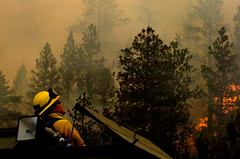
When a High Park Fire evacuees receive news that their houses have been destroyed in the flames, it’s likely they’ll believe that everything went with it.
“A lot of these owners really felt like their horses had been burned in the fire because they had already lost their house and knew they had lost their house,” said Haleigh Lundgreen, a fourth year veterinary student at CSU. “Some of these owners coming in, just going around from horse to horse hugging and crying and just being super appreciative of what we’ve done.”
At the Veterinary Teaching Hospital of CSU, more than 130 volunteers, students and employees have been treating and boarding the displaced animals of the High Park Fire victims. 109 dogs, cats, birds and other small animals have come through the hospital, which has been serving as an overflow shelter for the Larimer Humane Society since June 11.
“That’s probably the best part of it, is when [victims] see their own animal again,” said Rene Scalf, Supervisor of Critical Care Services at the hospital. “That’s probably when the most emotion comes out, when the people coming in have no idea if their animal made it out or not.”
Currently, every animal at the CSU vet hospital has been matched with their owners, including the one bearded dragon.
“He’s quite the character,” Scalf said.
2008 CSU alumna Ashley Mueller is a technician at the teaching hospital. Living in the Hewlett Gulch sub-division, she has been evacuated from the High Park Fire twice. Her pets are being housed at the hospital.
Once put on pre-evacuation, Mueller and her husband understood how quickly they would have to leave their home if the orders to evacuate were given.
“As soon as we got the pre-evac, we brought the chickens, the cats and the dogs down,” Mueller said.“And then while we were on pre-evac I’d bring them down during the day while I was working and I’d leave them in the kennel. And then I’d bring them home at night, and then bring them down the next morning for fear that if I was in town and 45 minutes away I couldn’t get them out.”
Mueller has experienced emergency evacuations before, but the High Park Fire is still shocking.
“I’ve never seen anything this extreme…You could just see it jumping from ridge to ridge to ridge to ridge,” Mueller said. “We pretty much assumed that our house was gone, but somehow the firefighters were amazing and they saved it.”
Scalf also has past experience with animal evacuations, working in Missouri during the 2011 Joplin tornado, as well as at Louisiana State University during Hurricane Katrina in 2005.
“I never thought I’d be doing this in my own backyard,” Scalf said.
The last time the teaching hospital experienced an event similar to the High Park Fire was the Spring Creek Flood in 1997.
“We did a very rapid intake for one night, and then it was resolved pretty quickly and things could go back,” Scalf said. “So this is a much longer situation. We know we’re in this for another week or two at least.”
While the teaching hospital has been taking in smaller pets, the Ranch in Loveland has been supplying medical attention and boarding for llamas, donkeys, goats, sheep and more than 200 horses. CSU students and faculty have been working at the Ranch as well.
“We had the large animal ambulatory team from CSU go out and help with any medical issues there,” Scalf said.
Dr. Brian Miller, head of Equine Field Service at CSU, has been working at the Ranch along with four fourth year veterinary students.
“It’s been good to see them work and letting them be veterinarians,” Dr. Miller said. “They get to react to emergency cases… interact with the owners, which is pretty important from that standpoint I think. I think they’ve really enjoyed making some decisions, and it’s been good for them.”
Lundgreen, who is one of the four vet students working at the Ranch, agrees.
“The biggest help has been what I learned in class and having the experience,” Lundgreen said, “and really I have to give a lot of credit to Dr. Miller and Dr. [Brittany] Bell because they were just awesome… they let us do a ton and actually do the veterinary work instead of just watching.”
Animals being held at the Ranch will be moved to different locations by June 30. The largest intake the teaching hospital has seen in a single day was 26 animals, which was this past Saturday when the fire grew.
“A lot of [the animals] were really hard to see when they came in really beat up…” Lundgreen said. “It’s amazing how these animals can actually survive. They have an ability to survive, and did really great.”
Related articles








